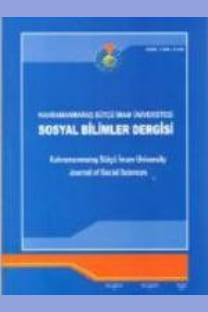Avrupa Birliğine Uyum Çerçevesinde Gümrük Rejimlerinin Değerlendirilmesi: Gümrük Birliğinin Türkiye’nin Dış Ticaretine Etkileri
Çekoslovakya Cumhuriyeti 1989 yılında Doğu Bloku’nun dağılmasının ardından dünya ile ekonomik entegrasyonu sağlayabilmek için 1 Ocak 1991 tarihinde serbest piyasa ekonomisine geçme kararı almış, ancak 1993 yılında demokratik oylamayla Çek ve Slovak Cumhuriyetleri olmak üzere iki bağımsız devlete dönüşmüştür. Bu çalışmada yaklaşık altı beş süren geçiş döneminde (1991-1995) bu ülkelerin ekonomisinde yaşanan gelişmeler ele alınmıştır. Çalışma sonucunda bu ülkelerin reformları başarılı biçimde gerçekleştirmelerine rağmen söz konusu dönemde ekonomik olarak ciddi sıkıntı yaşadıkları gözlenmiştir.
Anahtar Kelimeler:
Çek Cumhuriyeti, Slovakya, Ekonomik Büyüme, Özelleştirme.
An Evaluation of Customs Regimes according to European Union Complience Framework: The Effect of the Customs Union on Turkey’s Foreign Trade
Afterter the collapse of the Eastern Bloc in 1989 Czechoslovakia decided to integrate its economy with the world by implementing free market mechanism on January, 1, 1991, but in 1993, the country was divided into two independent countries, namely the Czech and Slovak Republics. This paper has intended to investigate economic performances of these two countries during the transition period (1991-1995). This paper concluded that although economic reforms were successfully implemented these countries witnessed hard times during the transition period.
Keywords:
Czech Republic, Slovakia, Economic Growth, Privatization.,
___
- Allison, C. ve D. Ringold (1996) “Labour Markets in Transition in Central and Eastern Europe: 1989-1995”, World Bank Technical Paper No: 352. Andress, M. (2003) “Czech Republic”, Europe Review: the economic and business report, (World of Information), 15th Edition, ss.86-96.
- Andress, M. (2003) “Slovakia”, Europe Review: the economic and business report, (World of Information), 15th Edition, ss.325-334.
- Appel, H. Ve Gould, J. (2000) “Identity Politics Economic Reform: Examinig Industry –State Relations in the Czech and Slovak Republics”, EuropeAsia Studies, 52, 111,131.
- Banerjee, B. vd. (1995) “Road Maps of the Transition: the Baltics, the Czech Republic, Hungary, and Russia”, IMF Occasional Paper No: 127, September.
- Fidrmuc, J., (2003), “Economic Reform, Democracy and Growth during PostCommunist Transition”, European Journal of Political Economy, 19, 583-60
- Hamilton, F.E. (1986) Industrialization in Developing and Peripheral Regions, Routledge.
- Hazlett, T. W. (1996) “Bottom-up Privatization: the Czech experience”, The Privatization Process: a worldwide perspective, (Edit. Anderson, T.L. – Hill, P.J.) Rowman & Littlefield Publisher, ss.97-114.
- Horvath, J. ve Jonas, J. (1998) “Exchange Rate Regimes in the Transition Economies Case Study of the Czech Republic: 1990-1997”, Centre for European Integration Studies Working Paper No. 11, 1-40.
- IMF (1996) World Economic Outlook May 1996.
- Ishiyama, J. T. ve Breuning, M. (1998) Ethno politics in the New Europe, Lynne Rienner Publishers.
- Kaiser, P. J. (1995) “The Czech Republic: an assessment of the transition”, East-Central European Economies in Transition, (Edit. Hardt, J.P. – Kaufman, R.F.), ME Sharpe, London/New York, ss.506-518.
- Manasian, D. (1991) “A Survey of Business in Eastern Europe”, The Economist (Supplement) September 21.
- OECD, (1994) Economic Surveys: The Czech and Slovak Republics, Paris. -------,(2001) Agricultural Policies in OECD Countries: monitoring and evaluation, Paris.
- Pavlinek, P. (1995) “Regional Development and the Disintegration of Czechoslovakia”, Geoforum 26, ss. 351-372.
- Pavlinek, P ve Smith, A. (1998) “Internationalization and Embeddedness in East-Central European Transition: The Contrasting Geographies of Inward Investment in the Czech and Slovak Republics”, Regional Studies, 32(7), ss. 619-638.
- ISSN: 1304-8120
- Yayın Aralığı: Yılda 3 Sayı
- Başlangıç: 2004
- Yayıncı: Kahramanmaraş Sütçü İmam Universitesi
Sayıdaki Diğer Makaleler
Divânü Lügâti't-Türk’te Ettirgen Yapılar
Öğretmenlerin Okuma Alışkanlıkları
Medyanın Toplumda Güvenilirliği Ve Medya Etiğine Uyum İlişkisi
Kayseri'de oto ve otodan hırsızlık suçlarının cbs ile haritalandırılması ve analizi
Ömer TEMİR, Murat KARABULUT, Mehmet GÜRBÜZ
Çağatayca Kitab-ı Mebde-i Nur Mesnevisi’nde Deyimler
Mehmet Emin SÖNMEZ, Mehmet Ali ÇELİK, Mutlu SEVEN
